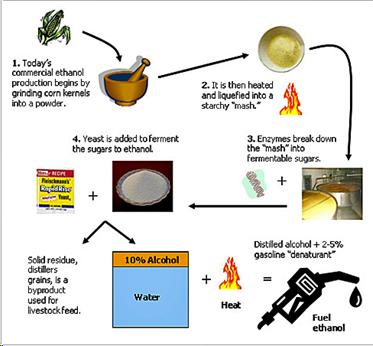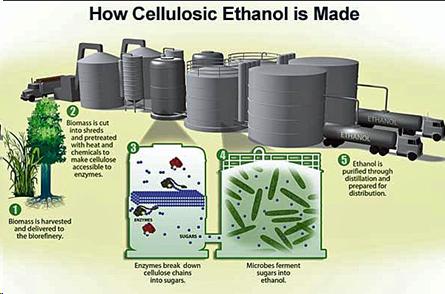Lecture Notes
We've seen this slide in an earlier lecture. On the left we see an image of how corn grain is converted into ethanol. On the right we see an image of biomass is converted into ethanol. Looking at corn, we start with corn grain that is ground up, heated, and liquefied. It produces a starchy mash, which is the component we're looking for. Enzymes break the starch down into fermentable sugars. Yeast is added to the sugars, which is distilled into ethanol. This process also results in dry distillers grain (DDG), which is used as animal feed. Generally about 2.77 gallons of ethanol per bushel of corn is created and about 18 pounds of dried distillers grain result, as well (a bushel of corn weighs 56 pounds or roughly 25 kilograms). There are additional steps in converting biomass into ethanol. First, the biomass needs to be chopped. It's then treated with heat and different chemicals - sometimes acid, sometimes alkaline materials - that break the cellulose free from the lignin and hemicellulose. Enzymes are then added to break the cellulose molecules into the 6-carbon sugars. Microbes such as yeast, are used to ferment the sugars into ethanol. At present, we can produce approximately 75-85 gallons of ethanol per dry ton of biomass, and we will use 80 gallons per ton as our number. It's hoped that as our technology improves, the process of converting feedstock into ethanol can produce as much as 120 gallons of ethanol per dried ton of biomass, a significant improvement over the 75-85 gallons we're able to produce at the present. We can convert corn into ethanol on a commercial scale - we're doing more than 13 billion gallons a year. Converting biomass to ethanol is a much more of a challenge (the first couple of refineries will come on line this year), and it's not as easy as the corn starch conversion. Conversion in laboratories works well using small quantities of biomass in individual batches. To be commercially acceptable, we need to not only develp a much larger scale of conversion, but we also need to do it on a continuous basis so we're not starting and stopping. The ideal process will have biomass fed in at one end and through continuous processing, ethanol will be the resulting product. That's proven to be a much greater challenge than it has making corn-based ethanol. Biomass variability is another concern that we need to address. Plant biomass can vary from crop to crop, from year to year with the same crop, and from site to site. Biologically originating enzymes and yeasts that work across a broad spectrum of biomass having different compositions is difficult. Corn grain is fairly consistent from crop to crop and it's not necessary to release cellulose from lignin when making ethanol from corn grain. Going from from batrches at lab scale to a continuous commercial scale and also the biomass variability are two issues that require attention when moving cellulosic ethanol production forward.




